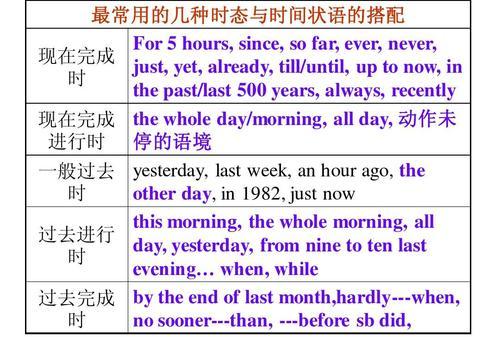英语时态和时间状语密切相关,不同的时态中时间状语的使用存在差异。一般现在时表示经常性或习惯性的动作,常用时间状语有always,usually等;现在进行时表示正在进行的动作,常用时间状语有now,at the moment等;一般过去时表示过去某时间发生的动作,常用时间状语有yesterday,last night等;过去进行时表示过去某时间正在进行的动作,常用时间状语有at that time,at 9 o'clock等;一般将来时表示将来某时间要发生的动作,常用时间状语有tomorrow,next month等;将来进行时表示将来某时间正在进行的动作,常用时间状语有at this time tomorrow,at 7 o'clock tomorrow evening等。

一般现在时
一般现在时表示经常性、习惯性或普遍性的动作,在使用时间状语时,常见的有:always,usually,often,sometimes,seldom,rarely,never等。
例如:I always drink coffee in the morning.(我每天早上都喝咖啡。)
现在进行时
现在进行时表示正在进行的动作,时间状语通常用来表示具体的时间点或者时间段,常见的有:now,at the moment,at present,these days等。
例如:She is studying for her exam at the moment.(她现在正在准备考试。)
一般过去时
一般过去时表示过去某个时间发生的动作或状态,时间状语通常用来表示具体的时间点或者时间段,常见的有:yesterday,last night,last week,a year ago等。
例如:I went to the gym yesterday.(昨天我去了健身房。)
过去进行时
过去进行时表示过去某个时间正在进行的动作,时间状语通常用来表示具体的时间点或者时间段,常见的有:at that time,at 9 o'clock等。
例如:They were watching TV at that time.(他们那时正在看电视。)
一般将来时
一般将来时表示将来某个时间要发生的动作或状态,时间状语通常用来表示具体的时间点或者时间段,常见的有:tomorrow,next month,in two weeks等。
例如:I will go to the beach next weekend.(我下个周末要去海滩。)
将来进行时
将来进行时表示将来某个时间正在进行的动作,时间状语通常用来表示具体的时间点或者时间段,常见的有:at this time tomorrow,at 7 o'clock tomorrow evening等。
例如:We will be having dinner at this time tomorrow.(明天这个时候我们正在吃晚餐。)

